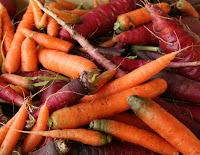From Bill:
Do you
enjoy a good artichoke? Well now is the time
to start them if you do. Unlike most
vegetables, the best time to plant is from November through March. They’re not difficult to grow, and once
established an artichoke plant will produce for several years. I’ve had them last for seven years.
Start
by purchasing your artichoke plant(s) at a good nursery or garden center. I’ve found that the smaller less expensive
plants eventually do just as well as the larger ones.
When planting
be aware that artichokes do take up some space - as much as six feet in
diameter and generally 3-4 feet in height.
They need deep, rich, well-drained soil and the more sun the
better. I now have several plants, and
the amount of sun they get really makes a difference in production. The plants are drought resistant, but for robust
edible artichokes, regular water is necessary along with a monthly application
of nitrogen fertilizer. Usual production
is a harvest in the spring and a second crop in the fall, but with regular
fertilizing I find I can get artichokes through much of the year.
Harvest
the artichokes by cutting about 4 inches below the bud, preferably before it
starts to open. When a stalk is through
producing buds, cut it off close to the ground.
New shoots will appear around the old stalk.
The
main problem with artichokes in our area is aphid infestation. These are prevented by controlling for ants
that tend the aphids on the artichokes.
Use whatever method you favor, organic or otherwise, to keep the ants away
from your plants.
There
are several varieties of artichokes. I
grow three different ones and each has unique characteristics. So, you may want to be aware of differences
when purchasing your plants.
After
a year of growth, the roots can be divided and replanted 3 to 4 inches deep
with the shoot above the ground to provide additional plants.
And Terry Adds:
Consider
artichokes as a decorative food plant as well.
I’m planning to intersperse some in my front garden among the other
drought tolerant plantings. Their jagged grey foliage adds another
attractive texture that fits right in. We’re
also having success growing them in containers in the garden at Havens. Beautiful and delicious, what more can we ask
for?






